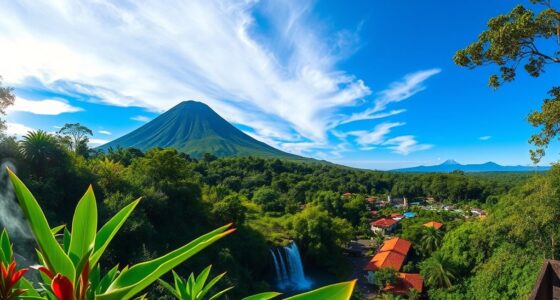Sustainable travel in Central America is thriving with eco-friendly accommodations, cultural experiences, and regional collaboration that benefit local communities. You can explore eco-lodges, participate in community-led initiatives, and enjoy authentic traditions while supporting conservation efforts. Improved infrastructure and digital strategies also make multi-destination trips easier and more seamless. If you want to discover how these initiatives are shaping responsible tourism and how you can contribute, there’s much more to explore below.
Key Takeaways
- Central America promotes eco-friendly accommodations, community involvement, and responsible tourism to preserve cultural heritage and natural environments.
- Regional collaborations enhance sustainable infrastructure, transport, and multi-destination travel experiences.
- Digital strategies like virtual tours, multilingual websites, and data analytics personalize eco-conscious travel options.
- Community-led initiatives and cultural preservation efforts support social stability and local economic development.
- Addressing infrastructure and digital challenges is vital for scalable, sustainable tourism growth in the region.
Growing Tourism Trends in Central America
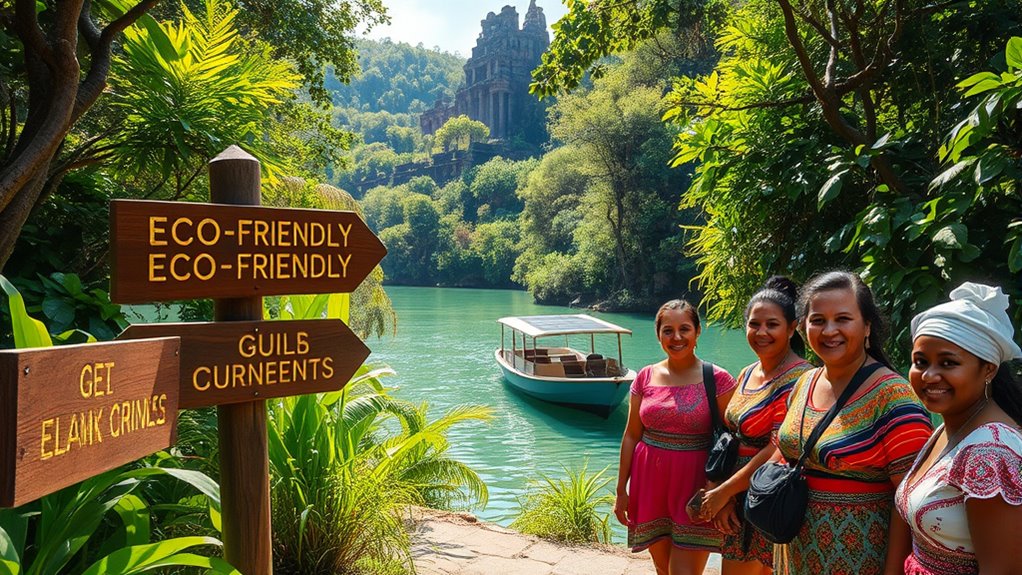
Growing tourism in Central America is driven by a steady increase in visitor numbers and evolving market preferences. You’ll notice more travelers choosing eco-friendly accommodations, authentic cultural experiences, and adventure activities that showcase the region’s natural beauty. Visitor numbers reached around 29 million in 2024, a 10% rise from the previous year, generating over US$26 billion in economic impact. Most tourists are overnight visitors from the U.S. and Canada, with a growing interest from within Central America itself. Demand for personalized, immersive travel experiences continues to grow, supported by digital marketing efforts and regional collaborations. As travelers seek sustainable options, countries are investing in eco-tourism and responsible resource management, ensuring tourism growth aligns with environmental preservation and local community benefits. Building secure attachments within the region also encourages longer stays and repeat visits, contributing to sustainable tourism development.
The Role of Regional Collaboration in Sustainable Development
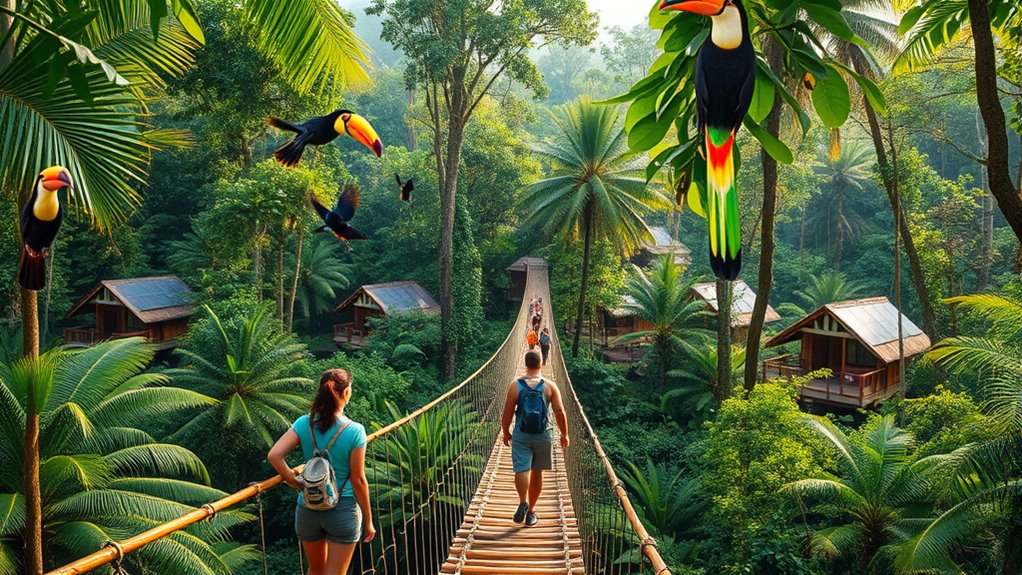
Regional collaboration plays a crucial role in advancing sustainable development across Central America, as countries work together to align policies, share resources, and promote joint initiatives. By coordinating efforts, you can help guarantee tourism growth benefits local communities and preserves natural resources. Regional bodies like the Central American Tourism Council (CCT) facilitate cooperation among nations, fostering sustainable tourism strategies and thematic routes that span borders. Collaborative projects, such as reef conservation in Belize and Honduras, demonstrate shared commitment to environmental preservation. Working together also improves connectivity, making multi-destination travel easier and more sustainable. Your involvement in regional initiatives helps distribute tourism’s benefits more evenly, reduces overtourism in hotspots, and strengthens resilience against economic and environmental challenges, ultimately creating a more sustainable and inclusive tourism industry across Central America. Additionally, implementing eco-friendly design principles in tourism infrastructure can significantly reduce environmental impact and promote conservation efforts throughout the region.
Key Eco-Friendly Accommodations and Experiences

Eco-friendly accommodations in Central America are transforming the region’s tourism landscape by prioritizing sustainability without sacrificing comfort. You’ll find eco-lodges, boutique hotels, and resorts designed to minimize environmental impact while offering authentic experiences. Many properties use renewable energy, rainwater harvesting, and local materials to reduce their footprint. You can stay in jungle lodges that support biodiversity or eco-resorts along pristine coastlines committed to marine conservation. These accommodations often involve local communities, ensuring your stay benefits the region economically and socially. Incorporating sustainable design principles into their construction and operations helps these establishments lead by example in responsible tourism.
Promoting Cultural Heritage Through Responsible Tourism
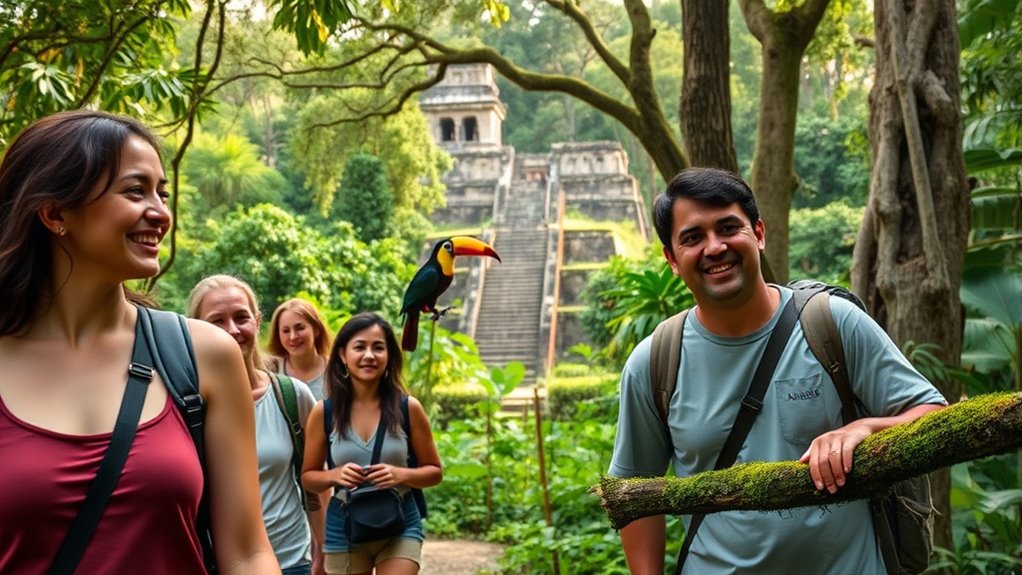
Promoting cultural heritage through responsible tourism means actively engaging you in authentic local experiences while safeguarding traditions and sites. You get to immerse yourself in indigenous crafts, traditional festivals, and historic landmarks that tell Central America’s unique stories. By choosing local guides and participating in community-led activities, you support artisans and preserve cultural practices. Respect for customs and environments is essential—you’ll be encouraged to follow guidelines that protect archaeological sites and cultural spaces. Responsible tourism also involves avoiding commercializing or damaging traditions, ensuring they remain vibrant for future generations. Your mindful participation helps balance the desire to explore with the need to conserve. Incorporating Cultural Intelligence into your travel approach can enhance your understanding and appreciation of local customs, fostering respectful interactions. In doing so, you contribute to a sustainable future where cultural heritage continues to thrive alongside tourism growth.
Innovative Digital Strategies for Market Expansion
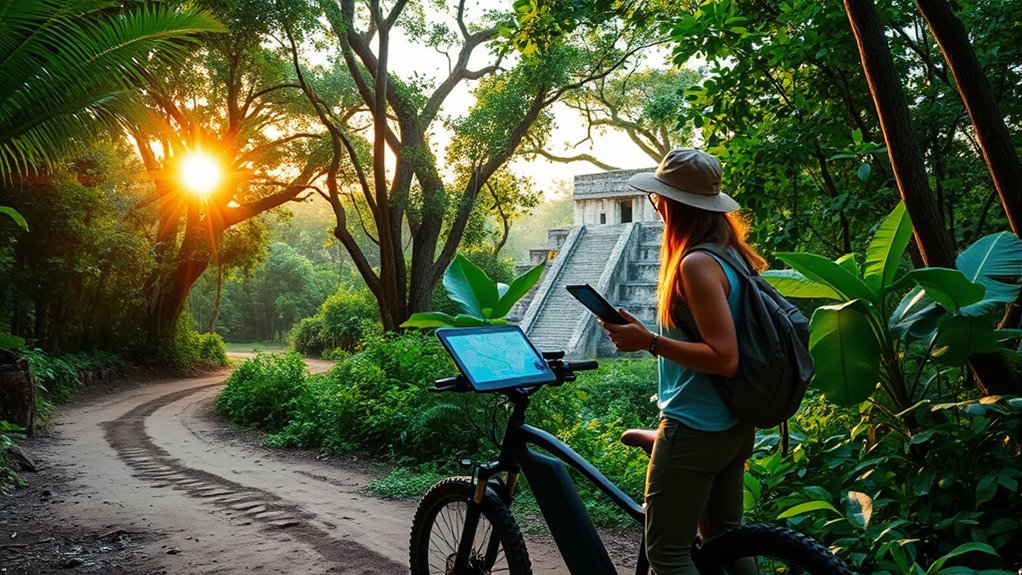
Digital strategies are transforming how Central American countries reach new markets and attract visitors. You can leverage innovative digital tools to showcase the region’s unique appeal, targeting specific traveler segments. By utilizing social media campaigns, you’ll engage potential visitors with compelling stories and visuals. Data analytics help you understand traveler preferences, allowing for personalized marketing efforts. Additionally, virtual tours and immersive content give prospects a taste of what they’ll experience, encouraging bookings. Incorporating high-quality visuals and color accuracy enhances the visual storytelling, making digital content more appealing and authentic.
Digital tools and targeted campaigns help Central America attract visitors and showcase its unique appeal.
- Use targeted advertising to reach key demographics like eco-conscious travelers and adventure seekers
- Develop multilingual websites to cater to international audiences
- Collaborate with influencers and travel bloggers to boost regional visibility
- Implement seamless booking platforms to enhance user experience and conversion rates
Protecting Natural Resources and Biodiversity
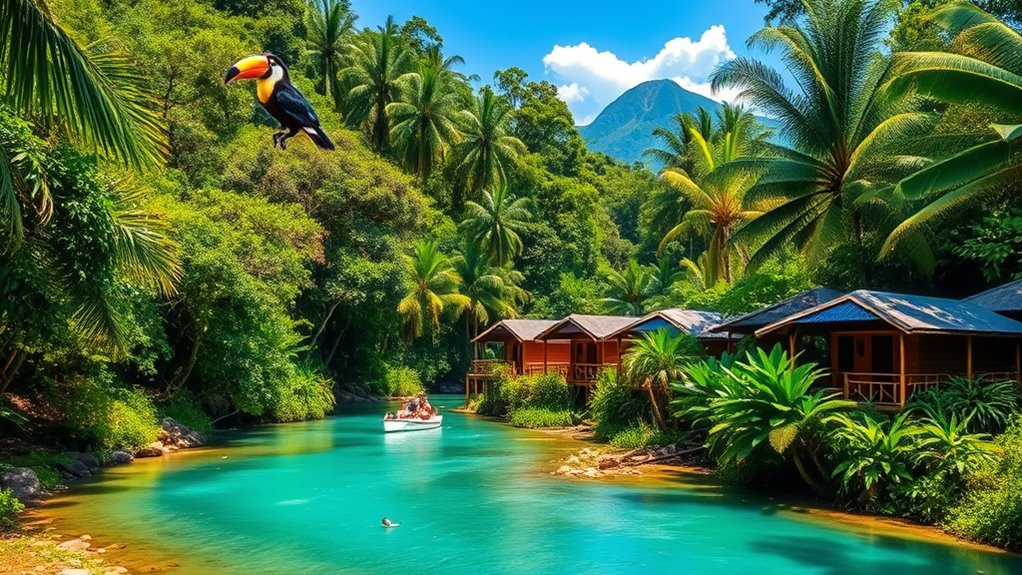
Protecting natural resources and biodiversity is central to Central America’s sustainable tourism efforts, as the region’s rich ecosystems attract eco-conscious travelers and support local livelihoods. You play a crucial role in respecting conservation policies and choosing eco-friendly options. Many countries collaborate on marine and forest preservation, implementing protected areas and reef management programs. Sustainable practices include reducing waste, avoiding single-use plastics, and supporting local conservation initiatives. Tour operators and lodges adopt eco-certifications to ensure responsible resource use. By engaging with these efforts, you help preserve biodiversity hotspots, such as coral reefs and cloud forests, for future generations. Your mindful travel minimizes environmental impact, promotes ecosystem resilience, and reinforces the region’s commitment to balancing tourism growth with natural preservation. Additionally, understanding the emotional significance of preserving these environments can deepen your commitment to sustainable practices.
Enhancing Connectivity for Multi-Destination Travel

Improving transport infrastructure and forging regional partnerships are key to making multi-destination travel seamless across Central America. By streamlining travel options and connecting attractions more efficiently, you can enhance visitor experiences while supporting sustainable tourism goals. Strengthening these links will help distribute tourism benefits more evenly and reduce pressure on popular sites. Incorporating regional transportation networks can further facilitate smoother movement between destinations and promote eco-friendly travel options.
Improving Transport Infrastructure
Enhancing transport infrastructure is essential for boosting multi-destination travel across Central America, as it directly impacts connectivity and ease of movement between countries. When you invest in better roads, airports, and transit systems, you make it easier for visitors to explore multiple destinations seamlessly. This reduces travel time, lowers costs, and encourages longer, more diverse stays. Improved infrastructure also supports sustainable tourism by spreading visitors across less crowded areas. To achieve this, focus on upgrading regional airports, expanding bus and rail networks, and developing eco-friendly transport options. Strengthening these systems benefits local economies and promotes regional collaboration. Ultimately, better transport infrastructure creates a more attractive, accessible, and sustainable experience for travelers exploring the rich cultural and natural diversity of Central America. Incorporating innovative grooming trends and eco-conscious practices can further enhance visitor satisfaction and environmental responsibility.
Promoting Regional Partnerships
Regional partnerships play an essential role in boosting connectivity across Central America by fostering collaboration among governments, airlines, and tour operators. These alliances streamline travel processes, making multi-destination trips easier and more appealing. You’ll see initiatives like coordinated flight schedules, shared marketing campaigns, and joint thematic routes that showcase diverse attractions across countries. By working together, stakeholders can reduce transit barriers, improve transportation infrastructure, and promote seamless travel experiences. This not only attracts more visitors but also disperses tourism pressure, supporting sustainability goals. Strong regional partnerships encourage the development of integrated travel packages, making it easier for travelers to explore multiple countries in one trip. Additionally, understanding 16PF traits can help stakeholders tailor services to diverse traveler preferences, enhancing overall visitor satisfaction. Ultimately, these collaborations create a more connected, resilient tourism network that benefits local communities and preserves Central America’s natural and cultural assets.
Facilitating Seamless Travel
How can Central America make it easier for travelers to visit multiple countries in one trip? By improving regional connectivity, streamlining travel processes, and promoting integrated transport options. You can experience more by taking advantage of thematic routes that connect key attractions across borders. To make this seamless, consider these strategies:
- Develop joint visa policies or simplified border procedures
- Expand regional flight and bus networks for better intra-country travel
- Create multi-destination packages with coordinated schedules
- Promote digital platforms for real-time travel updates and booking
- Invest in reliable transport infrastructure to ensure smooth journeys across borders
These efforts reduce barriers, save time, and encourage multi-country itineraries. Enhanced connectivity not only benefits travelers but also disperses tourism pressure, supporting sustainable growth across the region. Central America’s focus on integrated transport and collaboration makes multi-destination travel more accessible and enjoyable.
Supporting Local Communities and Socio-Economic Growth

Supporting local communities is essential for ensuring that the benefits of tourism reach those who need it most. When you travel responsibly, you help create opportunities for local entrepreneurs, artisans, and service providers. Your patronage can boost small businesses, preserve cultural traditions, and generate jobs, especially in rural areas. By choosing locally owned accommodations and tours, you contribute directly to economic growth. Sustainable tourism encourages community-led initiatives, ensuring that development aligns with local needs and values. Additionally, supporting community projects fosters social stability and preserves cultural identities for future generations. Your mindful participation helps distribute economic benefits more evenly, reducing inequality and strengthening resilience. Ultimately, your responsible travel choices empower communities, promote socio-economic growth, and reinforce the region’s commitment to sustainable development.
Alignment With Global Sustainability Standards
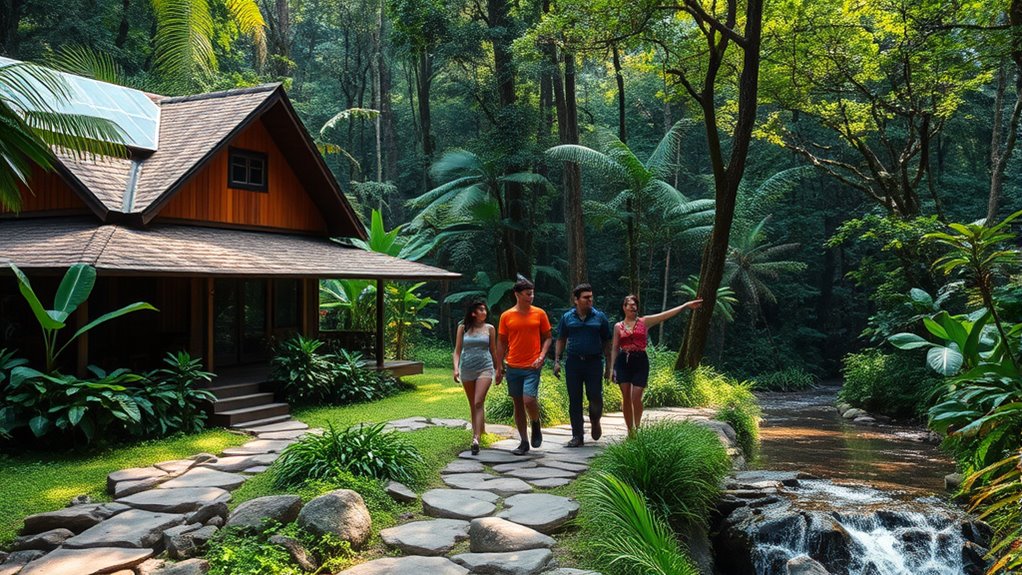
Aligning tourism practices with global sustainability standards helps guarantee that Central America’s growth benefits both people and the planet. By adopting international frameworks like the UN Sustainable Development Goals (SDGs) and the Global Sustainable Tourism Council (GSTC) criteria, you guarantee that tourism development is responsible and resilient. This alignment promotes eco-friendly operations, social equity, and cultural preservation. It also encourages transparency, accountability, and continuous improvement in your initiatives. As a traveler or stakeholder, you can support destinations that adhere to these standards, knowing your visit contributes to positive change. Implementing globally recognized practices helps prevent environmental degradation, supports local communities, and enhances the region’s reputation for sustainable tourism.
Aligning tourism with global standards ensures sustainable growth benefiting communities and protecting the environment.
- Embraces eco-certifications and responsible resource management
- Promotes community involvement and cultural integrity
- Ensures transparent reporting and sustainable investment
- Encourages continuous improvement through monitoring and standards
Future Opportunities and Challenges in Sustainable Tourism

As you explore future opportunities in Central American tourism, you’ll need to find ways to balance growth with conservation efforts. Infrastructure and connectivity gaps could hinder this progress, making regional coordination essential. Additionally, engaging local communities remains a challenge but is vital for ensuring sustainable and inclusive development.
Balancing Growth and Conservation
Balancing tourism growth with environmental conservation presents both significant opportunities and pressing challenges for Central America’s future. As visitor numbers increase, you have the chance to promote eco-friendly practices that protect crucial ecosystems, like coral reefs and rainforests. However, unchecked growth risks habitat destruction, pollution, and overuse of resources. To succeed, you need to focus on sustainable tourism policies that prioritize conservation while supporting local economies. This involves:
- Implementing strict environmental regulations for tour operators and accommodations
- Promoting eco-tourism and low-impact activities
- Developing community-led conservation projects
- Monitoring and managing visitor flow to avoid overtourism
Infrastructure and Connectivity Gaps
Despite growing demand for sustainable tourism in Central America, infrastructure and connectivity gaps pose significant challenges to supporting this expansion. Many destinations lack reliable transportation options, modern roads, and efficient public transit, making it difficult for visitors to access key sites sustainably. Limited regional connectivity between countries hampers multi-destination itineraries and reduces the region’s appeal for travelers seeking immersive experiences. Airports often require upgrades to handle increased passenger volumes and improve travel flow. Additionally, inadequate digital infrastructure constrains online promotion and booking systems essential for modern tourism. Addressing these gaps offers future opportunities to enhance regional integration, improve visitor experiences, and promote responsible travel. Investing in transport networks, digital connectivity, and infrastructure upgrades will be vital for sustaining growth and ensuring tourism development aligns with environmental and community priorities.
Community Engagement Challenges
Community engagement stands at the forefront of sustainable tourism development in Central America, presenting both significant opportunities and notable challenges. You need to involve local communities actively to ensure tourism benefits everyone and preserves cultural identities. However, challenges include overcoming resistance to change, ensuring equitable benefit distribution, and avoiding cultural commodification. Building trust takes time, and balancing external interests with local priorities can be complex. Effective engagement requires ongoing dialogue, capacity building, and respecting indigenous traditions. Without this, tourism risks alienating communities or causing environmental harm. To succeed, you must foster genuine partnerships and empower local voices.
- Address cultural sensitivities with respect and transparency
- Develop inclusive decision-making processes
- Promote community-led tourism initiatives
- Ensure benefits reach marginalized groups
Frequently Asked Questions
How Do Local Communities Benefit From Sustainable Tourism Initiatives?
You benefit from sustainable tourism initiatives by gaining new opportunities for employment and entrepreneurship within your community. These programs support local culture and traditions, helping preserve your identity while attracting respectful visitors. You also experience improved infrastructure and services, making daily life better. Plus, sustainable tourism encourages environmental conservation, ensuring natural resources remain healthy for future generations. Overall, it boosts your community’s economy and social well-being while respecting your environment.
What Are the Main Challenges in Balancing Tourism Growth With Environmental Protection?
Balancing tourism growth with environmental protection is tricky because increased visitor numbers can strain natural resources and ecosystems. You might face challenges like overtourism, habitat destruction, and pollution, which threaten biodiversity and local communities. To succeed, you need to implement sustainable practices, regulate visitor flows, and promote eco-friendly options. It’s about finding that sweet spot where tourism benefits everyone without harming the environment you’re working to preserve.
How Are Tourism Authorities Ensuring Responsible Visitor Behavior Across the Region?
Imagine you’re guiding a delicate butterfly through a lush garden; your gentle hands guarantee it doesn’t harm the vibrant blooms. Tourism authorities in Central America act similarly, promoting responsible visitor behavior through education, awareness campaigns, and community engagement. They foster a culture of respect for nature and local cultures, encouraging travelers to leave only footprints and take only memories, safeguarding the region’s treasures for generations to come.
What Role Does Government Policy Play in Promoting Eco-Friendly Travel Practices?
Government policies play a key role in promoting eco-friendly travel practices by setting regulations that prioritize environmental preservation and responsible resource use. You’ll find that policies support sustainable tourism development through incentives for eco-friendly accommodations, conservation initiatives, and community involvement. These measures encourage you to travel responsibly, minimize ecological impacts, and respect local cultures. By adhering to these policies, you help guarantee that tourism benefits the environment and local communities for generations to come.
How Is Climate Change Impacting Sustainable Tourism Development in Central America?
Climate change substantially impacts your sustainable tourism development in Central America by threatening natural attractions like reefs, beaches, and biodiversity hotspots. Rising sea levels, extreme weather, and ecosystem degradation challenge conservation efforts and eco-friendly initiatives. You need to adapt by implementing resilient infrastructure, promoting responsible travel, and supporting environmental preservation. These actions help maintain the region’s appeal, protect resources, and ensure long-term sustainable growth, benefiting both local communities and travelers like you.
Conclusion
Imagine your next trip as a seed you plant in Central America’s vibrant soil. By choosing eco-friendly stays, supporting local artisans, and respecting cultural traditions, you help cultivate a sustainable paradise. With regional collaboration and innovative strategies, the region’s tourism can flourish without stripping its natural and cultural treasures. Your mindful travel acts as water and sunlight, nurturing this beautiful landscape for generations to come—proving that responsible tourism truly makes a world of difference.





